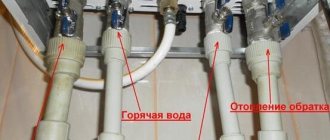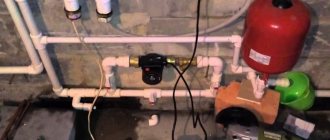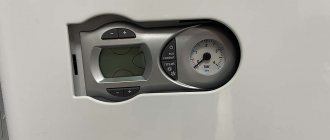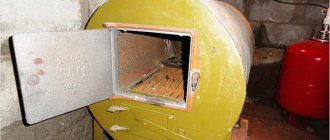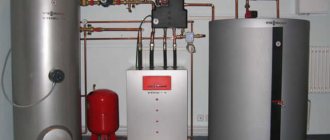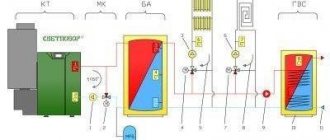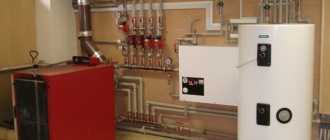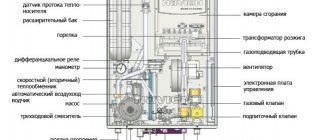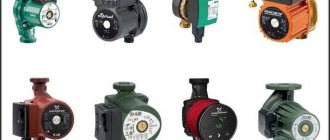Heating equipment is designed to make life easier and make living in the house comfortable. Why carry firewood and buy coal? It is much more convenient to connect a gas boiler to a common line. It can be mounted both on the wall and on the floor. But how to properly organize heating so that the coolant is distributed evenly throughout the system? How can you save on fuel consumption? Gas boiler piping diagrams will help you.
Selecting a heating system wiring diagram
There are several options for lining the boiler with polypropylene.
This scheme is selected individually for each house. What is optimal in one building may be ineffective in another. In addition, heating systems based on the principle of water movement are divided into: forced with a hydraulic pump and gravity (gravity, natural), there is also a classification based on the construction of pipelines. According to their structure, they are single- and double-pipe, collector beam or analogues with closed rings.
Which is better: gravity or pump?
In the gravity circuit, heated water flows from the boiler to the radiators by gravity. A hot coolant that has a high temperature always tends to replace a colder liquid. This heating boiler piping system is the easiest to assemble. In addition to the heater, it contains polypropylene pipes, radiators and an expansion tank.
In the version with top distribution, water, after heating, rises to the highest point - into the expander, and from there it goes down to the batteries. After the heat is released, it returns to the boiler, where it is heated again, then starting a new cycle.
This is how heating is installed in many houses in our country’s villages. Only there is a solid fuel stove. This is the simplest and cheapest way to organize heating for a small cottage. However, it has limitations both in the number of connected radiators and in the distance of the outermost one from the water heater.
The piping scheme with natural water movement is the simplest of all possible options, it has a minimum of nodes and connection points for polypropylene pipes
The compulsory system is more complex and expensive. However, it greatly simplifies the creation of comfortable temperatures in individual rooms. The coolant moves in it due to the stimulation of its movement by the pump.
The choice of polypropylene pipe layout and the boiler itself are closely related. The natural circulation system is energy independent. If the water heater does not require power from the electrical network, then even during power outages the house will be heated.
In a forced circuit, the pump requires a constant power supply to operate. Therefore, it is best to select a boiler for it that is dependent on electricity, which has additional capabilities. But in order to insure against voltage problems, you will have to purchase a backup generator or uninterruptible power supply.
Which heating scheme is better to choose?
There are many ways to route polypropylene pipelines from the boiler to the heating radiators.
But all these schemes are divided into:
- single-pipe;
- two-pipe.
In single-pipe systems, heated water supplied as a coolant is supplied and discharged through one pipe. In two-pipe systems for supplying coolant and return, i.e. to drain cooled water back into the boiler for heating, separate lines are constructed.
According to the method of connecting the working components, heating circuits are divided into:
- tee;
- collector
Tee types can be used for both gravity and forced circulation. The collector circuit can only work if there is a circulation pump.
A single-pipe circuit is obviously cheaper than a two-pipe circuit, but the radiator farthest in the chain from the boiler receives a minimum of thermal energy (+)
The single-pipe method involves laying one looped line and connecting batteries in series to it. In a two-pipe scheme, two independent pipelines with hot water and return flow from the boiler. And radiators are already connected to them.
With collector piping, one or two collectors are built into the system, from which separate pipes are routed to each battery. Also, such a distributor allows you to connect a “warm floor” made of the same PPR to the boiler.
Collector wiring makes it possible to create efficient heating systems for houses of large area and different number of storeys (+)
The use of collectors and separate risers for each battery leads to a significant increase in the cost of both design and installation. At the project preparation stage, more complex calculations have to be made. And during assembly, a much larger volume of polypropylene is consumed. But what we get is a system, each part of which can be adjusted to specific conditions and requirements.
The most popular scheme
Let's look at the procedure for creating the most popular type of binding - straight. The most common are energy-dependent boilers, so a piping scheme with an existing circulation pump will be described.
Necessary actions:
Installation of all devices
All radiators, washbasins, bathtubs or showers, and kitchen sinks are being installed. It is necessary that by the time the elements of the heating circuit or DHW are connected, all elements are installed and ready for connection.
The readiness of the heating line is especially important, since the hot water supply circuit works for delivery and can be expanded during operation.
Connecting heating system pipelines
All radiators are connected in series with each other by pipelines. One end is connected to the flush line (supply) of the boiler, the other to the return line .
It is important to ensure the tightness and integrity of the system. To avoid errors, you should constantly check the wiring diagram created during the design of the system.
DHW connection
A pipeline is installed, connected to the DHW pipe of the gas boiler. Taps for mixers are connected to the gap through tees . It is recommended that each mixer be equipped with its own ball valves to shut off the water supply when necessary.
The last step will be to connect the boiler to the power line - cold water supply . After this, you can make a test run and check the quality of work and integrity of all pipelines.
All detected errors are immediately eliminated, for which the system is stopped, the water is drained and the circuit is readjusted.
The nuances of strapping
Despite the fact that the harness is selected individually, there are several general provisions that must be adhered to:
- The boiler for schemes with natural heating circulation is installed below the level of the radiators.
- The base for installing floor-standing units must be made of non-combustible materials.
- Boiler rooms are equipped with ventilation and lighting.
- The boiler unit is connected with the inclusion of a coaxial chimney.
- After assembling and installing the unit and smoke ventilation systems, a safety group is installed: a control pressure gauge, a pressure relief valve and then an air vent.
- The expansion tank is installed between the hydraulic switch and the boiler unit.
Connecting a wall-mounted boiler
This type of boiler allows installation on the wall in the kitchen. Structurally, it is made in such a way that the necessary piping has already been carried out by the manufacturer, and its elements are supplied as a kit. Depending on the type of unit, they can be single or double circuit, so the number of pipes for piping may differ.
Wiring a wall-mounted gas boiler
Algorithm for piping a double-circuit gas boiler:
- Remove the plugs from the pipes.
- Install a strainer on the return line to remove dirt and suspended solids.
- A filter is installed to purify water from hardness salts; it can be installed on the common tap water inlet.
- When piping a wall-mounted gas boiler, shut-off and control valves with detachable connections, for example, “American” ones, are installed.
- The cold water pipes are located on the left side relative to the center of the boiler, and the hot water pipes are located on the right.
- The boiler is connected to the gas mains with the involvement of a certified specialist; the final approval of the boiler will be issued by a representative of Gorgaz after a test run of the boiler equipment.
- When piping a double-circuit gas boiler, the threaded gas connections are sealed only with tow.
- Install a special filter on the gas shut-off valve.
- The boiler is connected to the gas main with a corrugated hose and a union nut with a paranitic gasket.
Connecting a floor-standing gas boiler
This scheme requires a separate room to house the boiler, since floor-standing models are large and often have an open firebox design that works with natural circulation through the gas-air path. The scheme also includes a pump for coolant circulation, especially for piping a double-circuit gas boiler and for a multifaceted heating level: number of floors, different types of heating - radiator and “warm floor”.
The circuit for dual-circuit heating (heating and domestic hot water) consists of 5 pipes: 1 - gas, 4 - water coolant. The first is connected to the burner device with a ball valve.
Connection diagram for water coolant when piping a floor-standing gas boiler:
- Heating boiler inlet;
- heating boiler output;
- DHW heat exchanger inlet;
- DHW heat exchanger output.
The distribution of water flows is automatic, performed by a three-way valve, hydraulic arrow or balancing valves.
For piping a floor-standing gas boiler with extensive heating networks and a long distance, it is recommended to connect 2 collectors with an autonomous pump, for example, one for low-temperature coolant up to 50 C for a “warm floor” system, and the other up to 90 C for conventional radiators.
To reduce the temperature, the manifold can be equipped with a mixer or a three-way valve with a servo drive installed between the supply and return on the comb. Sensors allow you to set different temperatures in the circuits.
Thus, in order to properly tie the boiler, you will need not only experience in installation work, but also strict compliance with state operating rules and the requirements of the manufacturer.
What elements does the diagram contain?
The wiring diagram is a complex made up of the following elements:
- Circulation pump.
- Valves for various purposes (safety, check, distribution, etc.).
- Expansion tank.
- Ball valves - drain, balancing, etc.
- Pressure gauge.
- Filters for purifying liquids from solid particles.
As a rule, most of these components are built into a wall-mounted double-circuit boiler, and there is no need to duplicate them in the external part of the system. Elements such as a circulation pump, expansion tank, all taps and valves are initially present in the boiler design as components.
A modern unit practically does not require the installation of external components, connecting directly to the system. The exception is non-volatile boilers that are not equipped with a circulation pump and other important elements.
An important element of the piping is air removal devices. A circulation pump can perform this function, but the efficiency of the process is low and takes a long time.
It is easier to install Mayevsky taps on radiators and place the supply pipeline in a vertical position (on non-volatile systems) . In addition, pressure and temperature monitoring devices, which provide information about the operation of the system, are of great importance.
Shut-off valves allow you to regulate or cut off the system lines in case of emergency situations.
What is a harness and what is it made of?
The heating system has two main parts - the boiler and radiators or heated floors. What connects them and ensures safety is the harness. Depending on the type of installed boiler, different elements are used, therefore they usually consider separately the piping of solid fuel units without automation and automated (usually gas) boilers. They have different operating algorithms, the main ones being the ability to heat the boiler heater in the active combustion phase to high temperatures and the presence/absence of automation. This imposes a number of restrictions and additional requirements that must be met when piping a boiler running on solid fuel.
An example of a boiler piping - first there is copper, then there are polymer pipes
What should be in the harness
To ensure safe heating operation, the boiler piping must contain a number of devices. Must be:
- Pressure gauge. To control the pressure in the system.
- Automatic air vent. To bleed air trapped in the system so that plugs do not form and the movement of the coolant is not blocked.
- Emergency valve. To relieve excessive pressure (connected to the sewerage system as a certain amount of coolant is released).
- Expansion tank. Necessary to compensate for thermal expansion. In open-type systems, the tank is placed at the top point of the system and is a regular container. In closed heating systems (necessarily with a circulation pump), a membrane tank is installed. Installation location: in the return pipeline, in front of the boiler entrance. It can be inside a wall-mounted gas boiler or installed separately. When using the boiler to prepare water for domestic hot water, an expansion tank in this circuit is also required.
- Circulation pump. Mandatory for installation in systems with forced circulation. To increase heating efficiency, it can also be used in systems with natural circulation (gravity). Placed on the flow or return in front of the boiler before the first branch.
Some of these devices are already installed under the casing of a gas wall-mounted boiler. The wiring of such a unit is very simple. In order not to complicate the system with a large number of outlets, the pressure gauge, air vent and emergency valve are assembled into one group. There is a special housing with three outlets. The corresponding devices are screwed onto it.
This is what a security group looks like
Install a safety group on the supply pipeline immediately at the boiler outlet. They are placed so that it is easy to control the pressure and you can manually release the pressure if necessary.
What pipes to use
Today, metal pipes are rarely used in heating systems. They are increasingly being replaced with polypropylene or metal-plastic. Piping a gas boiler or any other automated boiler (pellet, liquid fuel, electric) is possible immediately with these types of pipes.
A wall-mounted gas boiler can be connected with polypropylene pipes immediately from the boiler inlet
When connecting a solid fuel boiler, at least a meter of supply pipe cannot be made with a metal pipe and, best of all, a copper pipe. Then you can switch to metal-plastic or polypropylene. But this is not a guarantee that polypropylene will not collapse. It is best to provide additional protection against overheating (boiling) of the TT boiler.
If there is protection against overheating, the boiler piping can be made with polypropylene pipes
Metal-plastic has a higher operating temperature - up to 95°C, which is sufficient for most systems. They can also be used to piping a solid fuel boiler, but only if there is one of the systems for protecting against overheating of the coolant (discussed below). But metal-plastic pipes have two significant drawbacks: narrowing at the connection point (fitting design) and the need to regularly check the connections, as they leak over time. So, lining the boiler with metal-plastic is done under the condition that water is used as a coolant. Antifreeze liquids are more fluid, so it is better not to use compression fittings in such systems - they will still leak. Even if you replace the gaskets with chemically resistant ones.
What else is needed in the system
The boiler piping will be incomplete if it does not have a tap to drain and fill the system. And it is better if they are separate. The specific installation location depends on the structure of the system, but there are certain rules:
- The drain tap is installed at the lowest point. This is very important if the heating system needs to be preserved for the winter - it is necessary that as little coolant remains in it as possible. If the system will operate constantly in winter, a tap (with or without a pipe) is usually attached to one of the radiators. This will be the place where the system drains. Such a valve for draining the system can be installed in any convenient place (on the return pipeline)
- If the heating system will use water, an inlet from the water supply is usually connected. In the case of a wall-mounted gas boiler, there is a special pipe with a stationary tap for this. Cold water is connected to this input; if refilling is necessary, the tap is opened for a short time. If a boiler without a special pipe is used, a tap is also installed in the supply pipeline (preferably higher). Alternatively, on a section of pipe that goes to the expansion tank.
One of the options for installing a tap for filling the heating system
In some systems, the drain and fill of the system are made from one tap. This is possible if there is a pump that pumps the coolant and there is a pressure gauge by which you can control the pressure created. If there is a separate tap for filling the system at a high point, it can be filled by gravity.
How to do it yourself in a private house. Rules and scheme of actions
According to the PUE, in order to make grounding through an outlet directly yourself, it must be connected according to the diagram not to the panel board, but directly to the circuit.
One of the main requirements for the grounding loop is that the resistance of the system as a whole should not exceed 4 ohms. To do this, you need to correctly connect the circuit to the power panel using a conductor made of copper. One side of it is attached to the base of the house, and the other to the zero on the shield.
Photo 2. Ready-made kit for grounding a wall-mounted gas boiler with all the necessary components.
To independently implement a grounding device, you can use the following methods:
- Buy a ready-made kit for grounding a gas boiler. It includes all the necessary components. Installation is quite quick and does not take much time. You will need a small area of 0.5x0.5 m2. Grounding can be carried out in the basement or a few meters from the house itself.
- Make your own ground electrode. To do this you will need a welding machine and a steel angle. The created structure, in the form of a triangle or an inverted letter Ш, is dug into the ground to a depth of more than 1 meter.
Reference! Before starting work, it is necessary to install an independent external grounding loop near the house.
Tools and materials
The process is done thanks to the following tools:
- According to the markings made, a trench is dug with a shovel.
- Grounding conductors are driven into the drilled holes with a hammer.
- Using a motor drill, deep holes are drilled in the upper part of the trench.
- To connect the corners between the horizontal elements of the ground loop, a metal tape is used. Electric welding is required for connection.
- At the end of the conductor entering the room, an M6 or M8 bolt is welded. A wire ring is placed on it, which is responsible for the internal grounding of a private house.
Materials used:
- Metal corner (size 50x50x5 mm). The house grounding loop is an equilateral triangle, into the corners of which metal grounding conductors are driven.
- Steel strip 40 mm wide and 4 mm thick. In order to join the corners together, a metal tape is used.
- Metal wire rod with a diameter of 8–10 mm. It is laid in a trench and raised above the level of the blind area by 50 centimeters.
How to ground a circuit: work process
To properly and effectively ground a gas boiler, it is necessary to create an external circuit.
Contour manufacturing process:
- Markings are made at a distance of one meter from the house. An equilateral triangle with sides of 2 m is drawn.
- A trench 50 cm deep and 40 cm wide is dug along the drawn lines.
- Next comes the connection to the house using a trench of the same size.
- Deep holes are made with a drill.
- Grounding conductors are inserted into the pits. The distance to the bottom of the trench should be about 15 cm.
- The ground electrodes are connected to each other using metal strips 40x4 mm.
- They place a metal strip in the trench leading to the house.
- Weld a strip of metal to the base using a metal rod.
Attention! Such equipment of a grounding system is possible only if there is a sufficient amount of land near the house. If it is impossible to ground the boiler using a triangular circuit, linear grounding is used
How to start the boiler after installation
The first launch is carried out in stages:
- The system is slowly filled with water. This is necessary so that all the air has time to escape. Fill until the pressure is 1-1.5 Bar.
- Check the condition of all connections, look for possible leaks.
- After this, gas is supplied and the boiler is tested. These actions are performed by technicians from the service center. They determine what adjustments need to be made to the factory settings, determine the upper and lower limits of temperature conditions, and perform other necessary actions. Starting the boiler on your own is not recommended even for experienced people, and this procedure is strictly prohibited overnight.
Types of heating boilers
Conventionally, heating boilers can be divided into autonomous and manual loading.
Depending on the fuel used, autonomous boilers are:
- solid fuel;
- electrical;
- gas;
- liquid fuel.
The order in the list determines the cost of heating depending on the type of fuel: gas boilers will be the cheapest to operate.
These boilers are equipped with automatic maintenance of the specified coolant temperature. They can work all year round throughout their service life. There are wall mounting and floor mounting types.
Manual loading boilers include solid fuel boilers. Firewood, peat and coal are used as fuel. Requires human intervention to load fuel.
Maintaining the required coolant temperature is also a person’s responsibility.
Boiler design is floor-standing. Equipped with a minimum set of automation. Heating boilers are single- and double-circuit. A water supply is connected to the double-circuit boiler, which is built to heat hot water.
Heating systems with a heating boiler must provide the required temperature in the rooms being treated. The wiring diagram should be oriented towards uniform heat supply to all devices
No. 1 - features of automatic type boilers
In most modern gas boilers for autonomous heating, the coolant temperature is maintained automatically.
Inside the unit there is a heat exchanger heated by a burner using liquid or gaseous fuel. The boiler temperature sensor constantly monitors the temperature of the coolant.
As soon as the temperature reaches the set point, the burner goes out and heating stops. When the coolant temperature drops below a preset limit, the burner is re-ignited.
Such ignition-extinguishing cycles can occur quite often, there is nothing wrong with that.
If you plan to install a heating system with high performance, then there is a possibility of overheating of the coolant. In such piping schemes it is necessary to provide a thermal accumulator
The vast majority of installed heating boilers heat the coolant by processing gas or liquid fuel.
This is facilitated by widespread gasification and high reliability of boilers.
The piping schemes with solid fuel boilers do not provide for adjustment of the heat supply, because The combustion process cannot be controlled. If combustion stops, the circulation pump stops working
Advantages of gas and liquid fuel boilers:
- ease of maintenance;
- many security systems, often redundant;
- Some equipment is included in the kit (circulation pump, pressure gauge).
The undoubted advantage is the high efficiency, which averages 98%.
Heating systems can circulate water with a temperature of no more than 105 °C, steam heated up to 130 °C, or air up to 60 °C. When operating parameters are exceeded, the safety group is triggered
There are also disadvantages:
- in the event of a lack of electricity, the entire system stops, creating the threat of defrosting;
- high price;
- the circulation pump operates around the clock;
- can only be used in closed systems.
When installing an autonomous boiler, you need to take into account the constant costs of electricity. The circulation pump runs constantly, regardless of whether the coolant is being heated or not.
No. 2 - manually loaded solid fuel boilers
In solid fuel boilers, fuel is loaded and ignited manually. The combustion intensity can be adjusted within a limited range. The operating time is determined by the fuel burning time of one load.
Solid fuel boilers are the most universal solution; their advantages include:
- independence from electricity;
- can be used in closed and open systems;
- low price.
Units of this type operate on the most accessible type of fuel.
There are significant disadvantages:
- as a rule, they are supplied with a minimum set of equipment;
- require constant human supervision;
- have low efficiency.
To solve traditional “winter” problems, one option may be to use two boilers of different types in one heating circuit.
In normal mode, the autonomous boiler operates, and in the event of an accident on the gas or electric line, the solid fuel heating unit is manually started.
This scheme will not allow the heating system to overcool and freeze. The second option may be to use a special, non-freezing coolant - antifreeze.
The choice of heating boiler piping scheme largely depends on the type of heating unit.
When installing a solid fuel boiler, it is very important to maintain all distances from the walls
What requirements must be observed during installation?
When performing installation work, you will have to combine two types of requirements:
- Installation conditions set out by the manufacturers.
- Norms and rules for working with gas equipment.
The installation procedure is always described in detail in the instructions. Even if there are no specific requirements, any manufacturer must outline the procedure.
To install wall-mounted units, you must:
- The presence of a strong, ideally load-bearing wall, capable of supporting the weight of the boiler.
- Installation on thin or plasterboard partitions is prohibited.
- Gas boilers with an open burner require a separate room. If installation is in the kitchen, there must be a door and window opening.
Floor-standing boilers have their own requirements:
- The installation is carried out on a layer of asbestos covered with a sheet of metal. This seems unnecessary, but most manufacturers, as well as gas service workers, are unanimous on this.
- The room is separate, ventilated, with access to any point of the boiler.
- The distance from the walls to the surfaces of the unit is at least 0.3 m (for some installations it is greater, please check the instructions).
- The room used as a boiler room should be free of trash, flammable materials, and foreign objects. There should always be quick access to the window, and access to the boiler from all sides should be free.
When mounted in the kitchen, it is allowed to use a quick-detachable decorative box with opening doors.
The gas service requirements are a separate list of conditions. The main one prohibits unauthorized actions with gas equipment . According to it, no one, except gas specialists who have all the required permits and approvals, has the right to install, move or perform other actions with gas appliances.
There is a fine for violation. According to the rules, upon commissioning, the owner undergoes instructions, signs in the log and begins to bear full responsibility. In practice, the situation is somewhat confusing, since these rules were developed for residents of apartment buildings.
Therefore, in most cases, some deviations from the norms are ignored, provided that they do not pose a danger.
In particular, they usually make a compromise - the owner can connect the boiler to the gas supply pipeline, but the connection of this pipeline to the main line is carried out by specialists.
NOTE!
According to Art. 7.19 of the Code of Administrative Offenses of the Russian Federation, unauthorized connection to gas networks is punishable (for individuals) with a fine of 3-4 thousand rubles. Any inspector from the gas service can qualify the connection as unauthorized, so all actions should be agreed upon in advance.
Why is proper strapping so important?
Piping refers to pipes and mechanisms designed to supply coolant from the boiler to the radiators. This is almost the entire heating system, with the exception of the batteries.
The system consists of many components, but even a non-professional can install the simplest boiler piping. But if you need a complex circuit, it is better to contact an experienced craftsman.
It is better to install the boiler in a separate room, for example, in an outbuilding, boiler room or basement, because piping involves additional pipes and mechanisms, which is not always convenient. However, if there is not enough space, heating equipment is installed in the house
The choice of piping scheme for each specific house depends on the type of boiler, construction features, and type of heating system.
Any gas equipment is dangerous. Incorrect connection is fraught not only with heating problems, but also with explosions and destruction, so it is necessary to strictly follow the rules and regulations and comply with safety requirements. The main documentation that is relied upon when installing a gas heating system is SNiP.
The main unit of the system is the boiler. The piping scheme is chosen based on its type, location (wall-mounted or floor-mounted model), design features
It is necessary to carefully plan the heating scheme, the location of equipment, and the features of laying pipelines.
The boiler piping performs several significant functions at once:
- Pressure control. If the piping is installed correctly, thermal expansion is compensated, which means that the pressure in the system will not increase to critical levels.
- Removing air. Air bubbles form plugs, which reduces the efficiency of water heating: radiators do not warm up completely, but resource consumption remains the same. High-quality boiler piping is necessary to prevent this problem.
- Prevention of blockages in the system. If the boiler is not properly sealed, the risk of scale formation in radiators and pipes increases. Small debris in the coolant pollutes the system, which leads to excessive fuel consumption and increased heating costs while simultaneously reducing its quality.
- Possibility of connecting other circuits. You can install an underfloor heating system and a storage boiler.
In many ways, heat supply depends on the correct connection of the boiler to pipelines and other important components, so the gas boiler piping scheme must be carefully thought out and installed as efficiently as possible.
When installing a radial system, collector cabinets are installed where most of the boiler piping mechanisms can be mounted. It's convenient and practical
A correctly selected and installed boiler piping will last for many years without accidents or repairs, and its cost will be optimal.
What materials are used
Materials for the manufacture of pipelines in heating systems are:
- Steel . In Soviet times, steel pipes were practically the only option. They are cheap and can withstand high pressure. The disadvantage is the need for welding work and the tendency to corrosion and the formation of limescale on the internal walls, which can completely block the cross-section of the pipeline. Later, stainless steel pipes appeared, which are not prone to lime deposits and corrosion.
- Copper . The most common material for creating piping for gas boilers. Connected by soldering, withstands high pressure. Not prone to corrosion or deposits on the inner walls of the tubes.
- Metal-plastic . Pipes appeared relatively recently. Their main value lies in the ease of installation - it does not require welding, all connections are made using wrenches. Metal-plastic pipes have plasticity, which in some cases makes it possible to do without fittings.
- Polypropylene . To install it, a special soldering iron is used, but it is inexpensive, like the pipelines themselves. Recently, this material has been actively used for assembling systems in private homes, since such pipes do not burst when frozen. The autonomous system assembled from polypropylene pipes will remain intact in the event of an accident, which is highly valued by users. The walls of the pipelines are quite thick, which some people think is a disadvantage.
- Low-density polyethylene (HDPE) . These pipes are also not burst by frozen water. However, HDPE pipes are not suitable for a heating system because they have a low operating temperature. They can only be used for the external part of underfloor heating systems.
The choice of the most suitable material is determined by the capabilities and preferences of the home owner.
It is recommended to make the system with a certain margin of safety, since redoing it in a finished and comfortable house is extremely expensive and difficult.
The principle of operation of a double-circuit gas boiler
Now we will begin to analyze the principle of operation of a gas double-circuit boiler. We have found out the purpose of individual components and modules, now this knowledge will help us understand how all this equipment works. We will consider the principle of operation in two modes:
- In heating mode;
- In hot water generation mode.
In heating mode, the boiler provides your home with heat.
Let us immediately note the fact that operation in two modes at once is impossible - for this purpose, double-circuit boilers are equipped with a three-way valve that directs part of the coolant to the DHW circuit. Let's look at the principle of operation when heating, and then find out how the equipment works in hot water supply mode.
In heating mode, a double-circuit boiler operates in the same way as a regular flow-through heater. When first turned on, the burner works for quite a long time, raising the temperature in the heating circuit to the set point. As soon as the required temperature is reached, the gas supply will be turned off. If an air temperature sensor is installed in the house, the automation will take its readings into account.
The operation of the gas burner in double-circuit boilers can also be affected by weather-dependent automation that controls the temperature of the outside air.
The heat from the operating burner heats the coolant, which is driven through the heating system in forced mode. The three-way valve is positioned to ensure normal water flow through the main heat exchanger. Combustion products are removed in two ways - independently or using a special fan located in the upper part of the double-circuit boiler. The DHW system is in a switched off state.
Operation in hot water mode
As for the hot water supply circuit, it starts the moment we turn the handle of the water tap. The resulting water flow triggers the three-way valve, which turns off the heating system. At the same time, the gas burner is ignited (if it was turned off at that time). After a few seconds, hot water starts flowing from the tap.
When switching to hot water supply mode, the heating circuit is completely turned off.
Let's look at the principle of operation of the DHW circuit. As we have already said, turning it on turns off the heating operation - only one thing can work here, either the hot water supply or the heating system. A three-way valve controls it all.
It directs part of the hot coolant to the secondary heat exchanger - note that there is no flame on the secondary. Under the influence of the coolant, the heat exchanger begins to heat the water flowing through it
The scheme is somewhat complicated, since it involves a small circle of coolant circulation. This operating principle cannot be called the most optimal, but double-circuit gas boilers with separate heat exchangers can boast of normal maintainability. What are the features of boilers with combined heat exchangers?
- Simpler design;
- There is a high probability of scale formation;
- Higher efficiency of DHW.
As we see, the disadvantages are closely intertwined with the advantages, but separate heat exchangers are more valuable. The design is somewhat more complicated, but there is no scale here
Please note that when the DHW is operating, the flow of coolant through the heating circuit stops. That is, its long-term operation can disrupt the thermal balance in the premises
As soon as we close the tap, the three-way valve is activated, and the double-circuit boiler goes into standby mode (or the heating of the slightly cooled coolant immediately starts). The equipment will remain in this mode until we open the tap again. The productivity of some models reaches up to 15-17 l/min, which depends on the power of the boilers used.
Advantages and disadvantages
The advantages include:
- It becomes possible to supply thermal energy to the premises through coolant circulation.
- The organization of hot water supply becomes possible.
- Some boiler models do not have built-in circulation pumps. The harness allows you to use external devices that completely solve the problem.
- Increasing the efficiency and economy of the boiler and the entire system as a whole.
The disadvantages of strapping can be considered:
- The need for careful design of the heating circuit.
- We have to perform a complex of complex and time-consuming work.
- For tying it is necessary to involve experienced specialists.
Despite the existence of some disadvantages, the operation of the system without strapping is impossible. Therefore, the main task becomes competent design and high-quality work of installers .
NOTE!
All attempts to minimize labor costs or financial costs in this case are dangerous - they can lead to destruction or unproductive operation of the system.
What does the strapping scheme not depend on?
First, let's say what the heating boiler piping scheme does not depend on. On the hydraulic part, the type of fuel or energy that the heat generator uses does not matter. The wiring diagrams for gas, electric and solid fuel heating boilers are no different. At the coolant inlet/outlet there is not much difference whether pellets serve as an energy source, gas or diesel fuel. In complex systems, specialists take into account the type of heat generator when choosing a rational piping scheme, but this difference is insignificant. Also, apart from the configuration, the piping of the floor and wall heating boiler does not affect anything. But single-circuit and double-circuit boilers have different piping in terms of connection to the hot water supply system.
Boiler connection features
Before you begin installing the boiler, it is worth considering all its operating features so that you can decide whether the gamble is worth the candle. There are some nuances, and it is also necessary to do the tying correctly, but more on that below. Among the things you should consider:
- To install gas equipment, you will have to provide good ventilation to the room where you plan to do it. Otherwise, combustion products will quickly clog the chimney, which may not end well.
- Wall-mounted models must be layered with fire-resistant materials, because the boiler also heats up and can easily burn a regular wooden wall.
- The space around the heating, as mentioned above, should be cleared in order to facilitate its maintenance and increase the safety of the installation as a whole.
- It is worth installing gas meters in the boiler room; they will help you monitor the operation of the ventilation and, if something happens, quickly turn off the autonomous heating.
Forced circulation
The method has become most widespread, since the pump intensively pumps coolant through the system and heating efficiency increases by 30%.
Advantages also include the ability to regulate temperature and low pipe consumption during installation. The system will still cost significantly more, since it is more complex and requires more devices. Installed elements require balancing, and the entire system requires regular maintenance. In addition, a source of electricity is required.
If you install a combined system, it will combine the advantages of both previous ones.
It can be switched to any mode using a bypass installed with the pump. In this case, the heating operation will not depend on the supply of electricity to the house. Date: September 25, 2022
Options for schemes with a boiler
When the standard power of the device of 9-13 liters is not enough to meet the needs of the residents (example: there is a bath in the bathroom), the system is supplemented with a boiler. If an indirect heating boiler is selected, then it is impossible to simulate the flow with an additional circulation pump, which is turned on and stopped by a thermostat signal.
An incorrect circuit leads to a problem in the form of prolonged heating of the boiler. During this time (up to 2 hours), the house is not heated and the rooms cool down. Plus, the boiler life is reduced due to the “clocking” effect and hot water entering the second circuit rather than cold. Bacteria multiply in the boiler itself.
The correct scheme is to connect an indirect boiler to the heating circuit. The thermostat is connected to the boiler automation. The DHW outlet pipes are simply plugged
In this scheme, heating between the circuits is provided by a three-way valve. The boiler loads in 20-25 minutes. The plugs do not affect the life of the heat generator.
More practical options are installing a layer-by-layer heating boiler (there are models for dual-circuit systems) or an electric storage tank. The first does not have a heat exchanger, which reduces the cost of the system. The second significantly improves the comfort of using hot water.
In a circuit with an electric boiler, check valves and safety valves are mounted on the supply pipe. The latter sometimes leaks water that needs to be disposed of. The safety valve requires manual inspection 2 times a month
In the case of an electric boiler, it is recommended to additionally install an expansion tank. And if the pressure in the system is more than 6-8 bar, you will need a pressure relief valve to reduce it.
Polypropylene - the optimal solution
Many experts are in favor of tying gas equipment with polypropylene. Their main argument is versatility and the ability to implement any scheme without any problems. On the other hand, an inexperienced master is unlikely to have to deal with systems of increased complexity.
It is better to entrust the development and installation of highly complex piping schemes to a specialist. An inexperienced technician may make mistakes that will lead to a decrease in the efficiency of the system or even jeopardize its performance
The main advantage of polypropylene pipelines is reliability. According to the manufacturers, their products last 40 years or more.
The material is resistant to high pressure (can withstand up to 25 bar), tolerates water hammer and temperatures of 95 degrees. There is also a drawback that must be taken into account: such a boiler piping reduces the efficiency of the heating system.
When designing a harness, it is better to give preference to a scheme that involves a minimum of surges. This will increase the chances of maintaining the integrity of the system in the future.
The connection of the boiler to the gas pipeline must be rigid (“American”, metal fitting). Of all types of gaskets, only paronite gaskets are suitable, because... plastic materials (rubber, foam, tow) are deformed, which leads to loss of tightness or a decrease in the internal diameter of the gas pipeline.
Advantages of Baxi boilers and equipment
The units are equipped with auxiliary devices of the same brand: a circulation pump for modifications with forced movement of the coolant, a blower fan in closed fireboxes and a safety group.
They ensure that the unit reaches factory operating parameters and have advantages in layout compared to devices that are assembled with components from different manufacturers.
The main advantages of BAXI boilers:
The latest modifications are available with a powerful self-diagnosis system, frost protection and antibacterial protection.
Integrated weather-dependent automation provides sanitary living conditions in the house, while guaranteeing low cost of generated thermal energy for heating and hot water needs.
Launch and setup
Before starting the boiler, check the pressure in the expansion tank; it must be at least 0.5 atm. Monitor the condition of the valves on the supply and return lines; they must be open.
The unit must be disconnected from power. Then they fill the heating system through the make-up valve to 1.5 atm and begin to bleed the air if a non-automatic air vent is installed in the network.
When air is released, the pressure will drop, so the device is alternately fed to the specified operating pressure.
Next, you will need to bleed the air from the internal circuit in the boiler; to do this, remove the working panel of the device; there is a screw for bleeding air on the pump.
Start the boiler in minimum mode, and warm up the circuit to a temperature of 50 C, turn it off with buttons, and from the power supply, and bleed the air at the boiler pump. The operation is repeated several times until all the air is removed from the air-filled heating system.
Next, the boiler is turned on to the operating temperature of the thermostat and the operation of the heating system is monitored to ensure that the set temperature is sufficient.
Additional installation recommendations
strictly forbidden to reduce the diameter of the internal cross-section of the connected pipes . The optimal value for a boiler up to 28 kW is at least 20 mm for heating and at least 15 mm for water supply.
If the boiler is not included in the circuit, it is wiser to install the device closer to the hot water tap, which is often used.
In the case of connecting underfloor heating, the system is complemented by a separate branch with a collector and a circulation pump.
Conclusions and useful video on the topic
The following video will clearly demonstrate the installation, connection and configuration stages of the Baxi boiler:
Information about the installation process of the Baksi wall-mounted boiler and the rules for connecting it is needed to control invited performers. Unfortunately, not all of them please with a conscientious attitude to work and knowledge of all the nuances. If the owner of a gas-using unit cares about his own safety and the normal operation of the device, the information we present will not be superfluous.
Would you like to tell us how you installed and set up a boiler with the Baksi logo in your home or country house? Do you have useful information on the topic that will be useful to future owners of the unit? Please leave comments in the block form below, post photos related to the topic of the article, and ask questions.
Systems with two boilers
If it is necessary to organize heating of the coolant in a closed circuit from two heat generators, use the parallel connection principle. Let us explain the algorithm for the joint operation of two boilers - electric and solid fuel (the piping is shown in the figure):
Important point. The above-described piping option can be used for any pair of boilers. When installing a wall heater, a second pump is not installed.
Two heat generators, for example, gas and electric, are easily connected through a heat accumulator. The turning on and stopping of both boilers can be organized in various ways - by the temperature of the water in the tank, by time using a timer. Check valves are not needed here.
If it is necessary to connect 2-3 units of thermal power equipment with several heating circuits, it is better to assemble a diagram of primary / secondary rings. The principle is as follows: all heat sources and consumers with their pumps are connected to a common ring made of a pipe of increased diameter Ø26...40 mm (depending on the number of branches). Circulation inside the ring is provided by a separate pump.
The order of equipment installation matters: the water heater receives the hottest coolant, followed by the batteries, and finally the TP (along the water flow)
In a system with natural coolant movement, two boilers are also combined in parallel. Here it is important to withstand slopes of pipes Ø40...50 mm, and also to avoid sharp turns, using bends at an angle of 45° or bends with a large bend radius.
The water diverges along two parallel branches with boilers. But the unit that is currently turned on will make it move by gravity; the pump starts at the request of the owner
Advice. A series connection of 2 units has a right to life, but it is better not to use such a connection. Water heated in the first boiler will pass through the cold heat exchanger of the second and will certainly lose some of the heat.
Pipe selection
To insert a gas boiler and perform wiring, it is recommended to use metal-plastic or PP pipes. In terms of their characteristics, they are not inferior to copper or galvanized ones, installation is quite simple, and the cost is lower.
The wiring for heating radiators is made with metal-plastic pipes using press fittings or polypropylene pipes with aluminum reinforcement. The disadvantage of press fittings is their sensitivity to the quality of installation: at the slightest inaccuracy in placement, leakage occurs. A polypropylene pipeline elongates when exposed to temperatures above 50 °C. Both metal-plastic and polyethylene pipes are suitable for installing “warm floors”.
How to connect a heating boiler to radiators and heated floors
You purchased a new heating unit, intending to install it yourself and connect it to the heating network of a private home. Installation and piping of the boiler is carried out in various ways, depending on the energy carrier used, the type of piping and the availability of additional equipment:
To help you correctly connect the boiler to the heating system with your own hands, we suggest considering the existing connection options, then choosing the appropriate scheme.
Electric and diesel heat generators
Connecting a diesel fuel boiler to the radiator system is identical to piping gas-using installations. Reason: a diesel unit operates on a similar principle - an electronically controlled burner heats the heat exchanger with a flame, maintaining the set coolant temperature.
Clarification. The recommendation does not apply to heaters equipped with a homemade burner device that burns diesel and waste oil, for example, a Babington flare burner. An individual approach is needed here.
Electric boilers, in which the water is heated by heating elements, an induction core, or through the electrolysis of salts, are also connected directly to the heating. Automation located in an electrical cabinet connected to the network according to the electrical diagram provided is responsible for maintaining temperature and safety. Other connection options are shown in a separate publication on the installation of electric heating boilers.
Wall-mounted mini-boiler rooms equipped with tubular heaters are intended only for closed heating systems. To work with gravity wiring, you will need an electrode or induction unit, which is tied according to the standard scheme:
If you look at it, there is no need for a bypass here - the boiler will not work without electricity either
